LEGO's Business Model: Navigating Disruption and Smart Products
VerifiedAdded on 2023/06/13
|9
|2075
|485
Essay
AI Summary
This essay defines 'business model' and 'disruption' through a literature review and analyzes the opportunities and threats presented by smart-connected products to LEGO's existing business model. It examines how technological advancements impact LEGO's operations, product development, and competitive positioning, considering both the potential for innovation and the challenges of implementation. The analysis encompasses tangible and intangible resources, the micro-environment, and profit-driven objectives, concluding that while traditional business models may face challenges in rapidly evolving industries, they still provide a valuable framework for strategic management and focusing on key business aspects. This document is available on Desklib, a platform offering study tools and resources for students.
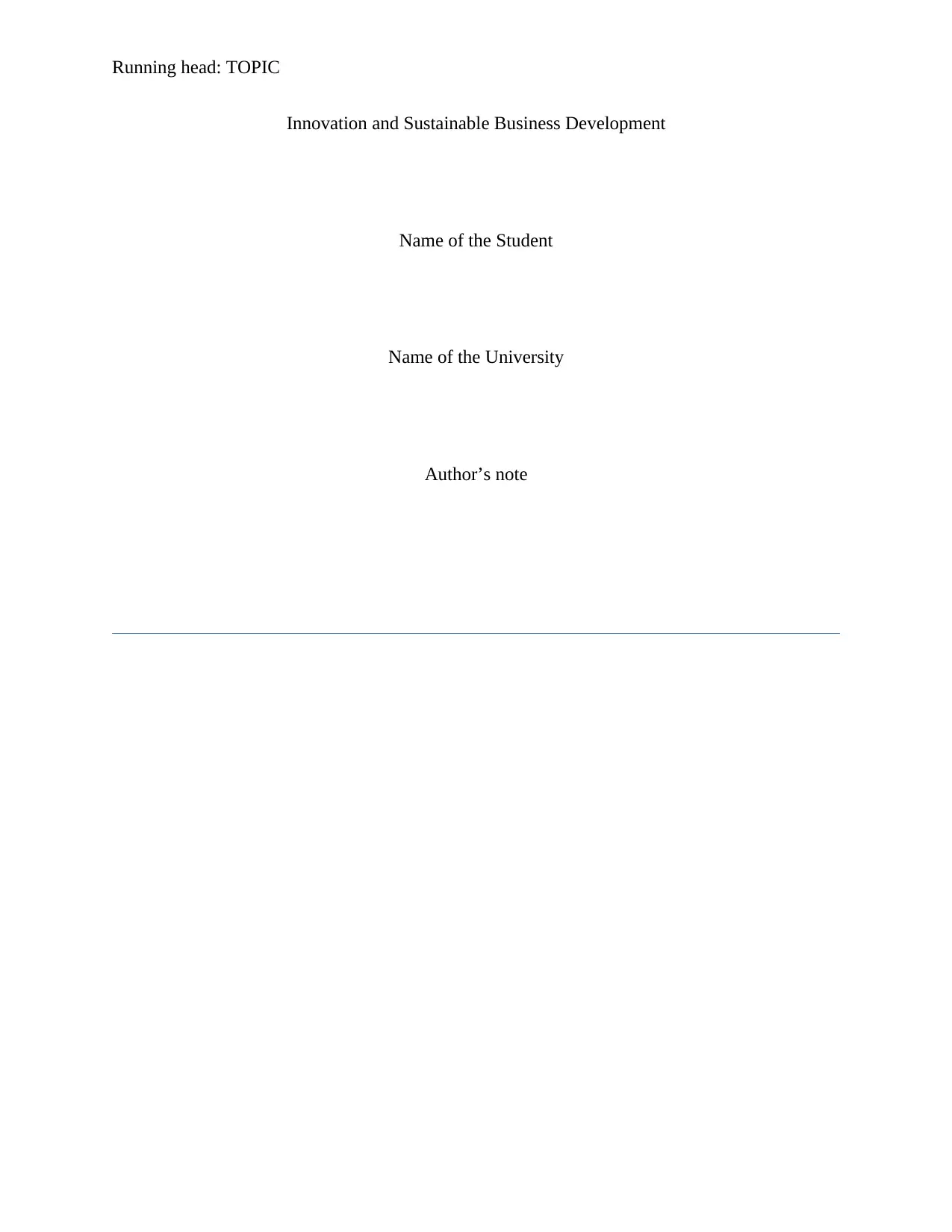
Running head: TOPIC
Innovation and Sustainable Business Development
Name of the Student
Name of the University
Author’s note
Innovation and Sustainable Business Development
Name of the Student
Name of the University
Author’s note
Paraphrase This Document
Need a fresh take? Get an instant paraphrase of this document with our AI Paraphraser
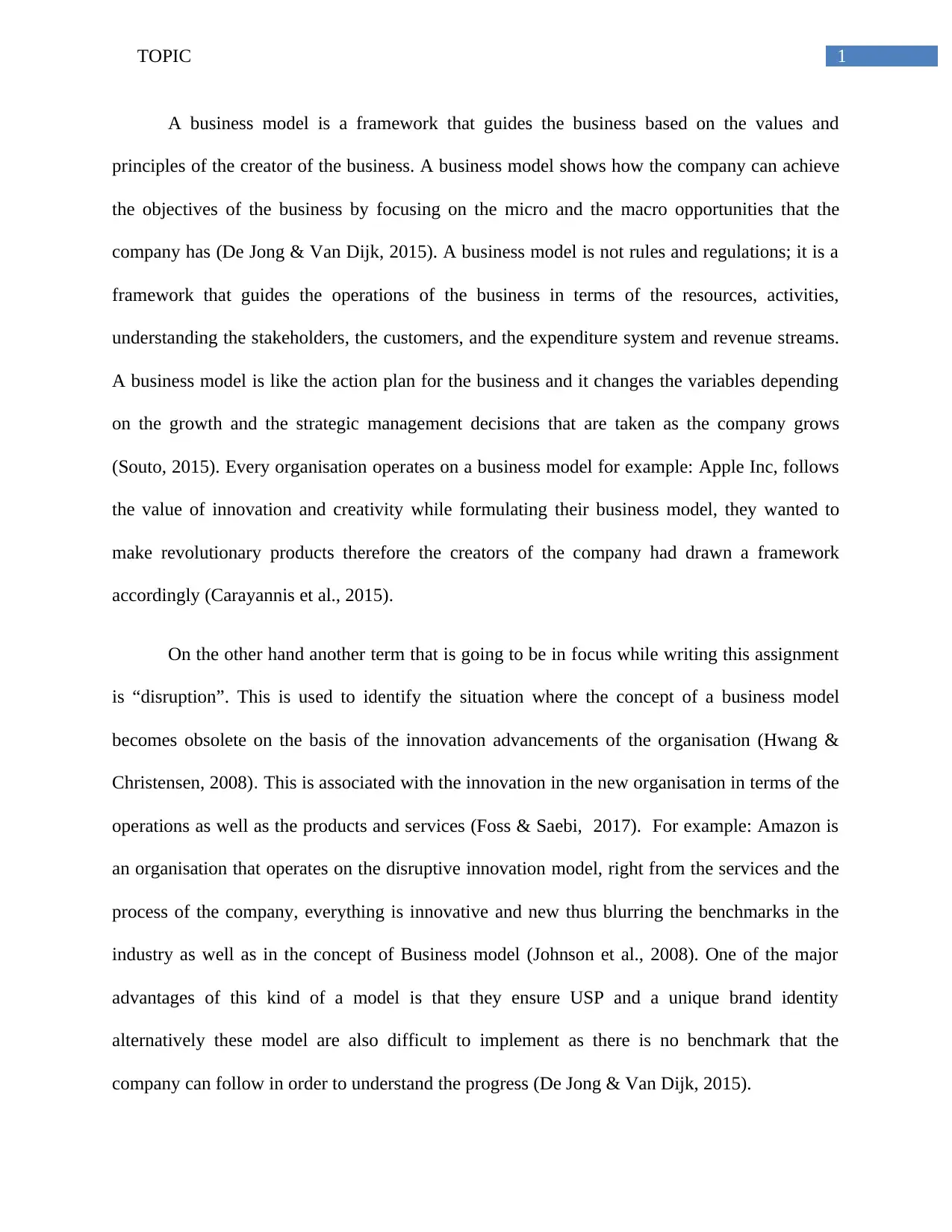
1TOPIC
A business model is a framework that guides the business based on the values and
principles of the creator of the business. A business model shows how the company can achieve
the objectives of the business by focusing on the micro and the macro opportunities that the
company has (De Jong & Van Dijk, 2015). A business model is not rules and regulations; it is a
framework that guides the operations of the business in terms of the resources, activities,
understanding the stakeholders, the customers, and the expenditure system and revenue streams.
A business model is like the action plan for the business and it changes the variables depending
on the growth and the strategic management decisions that are taken as the company grows
(Souto, 2015). Every organisation operates on a business model for example: Apple Inc, follows
the value of innovation and creativity while formulating their business model, they wanted to
make revolutionary products therefore the creators of the company had drawn a framework
accordingly (Carayannis et al., 2015).
On the other hand another term that is going to be in focus while writing this assignment
is “disruption”. This is used to identify the situation where the concept of a business model
becomes obsolete on the basis of the innovation advancements of the organisation (Hwang &
Christensen, 2008). This is associated with the innovation in the new organisation in terms of the
operations as well as the products and services (Foss & Saebi, 2017). For example: Amazon is
an organisation that operates on the disruptive innovation model, right from the services and the
process of the company, everything is innovative and new thus blurring the benchmarks in the
industry as well as in the concept of Business model (Johnson et al., 2008). One of the major
advantages of this kind of a model is that they ensure USP and a unique brand identity
alternatively these model are also difficult to implement as there is no benchmark that the
company can follow in order to understand the progress (De Jong & Van Dijk, 2015).
A business model is a framework that guides the business based on the values and
principles of the creator of the business. A business model shows how the company can achieve
the objectives of the business by focusing on the micro and the macro opportunities that the
company has (De Jong & Van Dijk, 2015). A business model is not rules and regulations; it is a
framework that guides the operations of the business in terms of the resources, activities,
understanding the stakeholders, the customers, and the expenditure system and revenue streams.
A business model is like the action plan for the business and it changes the variables depending
on the growth and the strategic management decisions that are taken as the company grows
(Souto, 2015). Every organisation operates on a business model for example: Apple Inc, follows
the value of innovation and creativity while formulating their business model, they wanted to
make revolutionary products therefore the creators of the company had drawn a framework
accordingly (Carayannis et al., 2015).
On the other hand another term that is going to be in focus while writing this assignment
is “disruption”. This is used to identify the situation where the concept of a business model
becomes obsolete on the basis of the innovation advancements of the organisation (Hwang &
Christensen, 2008). This is associated with the innovation in the new organisation in terms of the
operations as well as the products and services (Foss & Saebi, 2017). For example: Amazon is
an organisation that operates on the disruptive innovation model, right from the services and the
process of the company, everything is innovative and new thus blurring the benchmarks in the
industry as well as in the concept of Business model (Johnson et al., 2008). One of the major
advantages of this kind of a model is that they ensure USP and a unique brand identity
alternatively these model are also difficult to implement as there is no benchmark that the
company can follow in order to understand the progress (De Jong & Van Dijk, 2015).
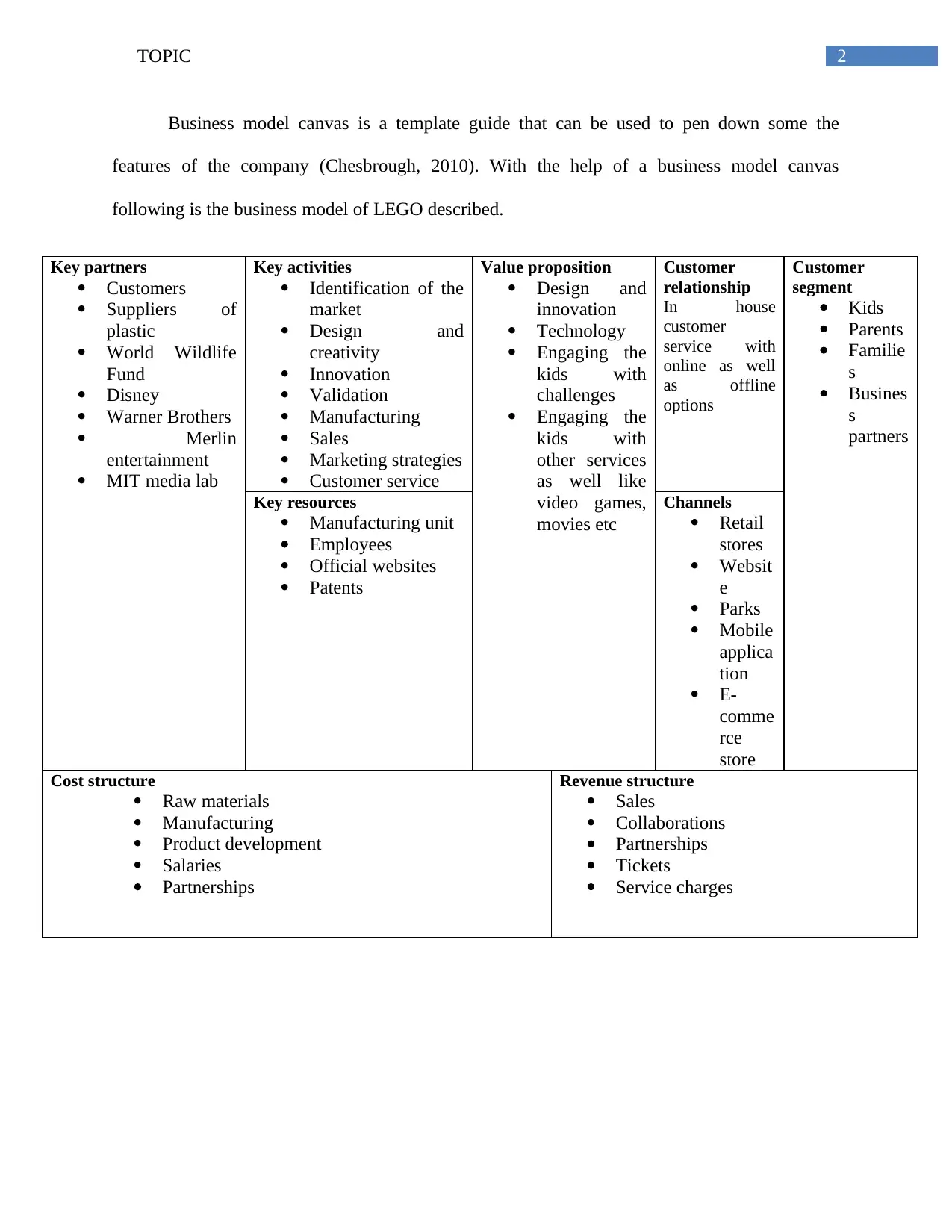
2TOPIC
Business model canvas is a template guide that can be used to pen down some the
features of the company (Chesbrough, 2010). With the help of a business model canvas
following is the business model of LEGO described.
Key partners
Customers
Suppliers of
plastic
World Wildlife
Fund
Disney
Warner Brothers
Merlin
entertainment
MIT media lab
Key activities
Identification of the
market
Design and
creativity
Innovation
Validation
Manufacturing
Sales
Marketing strategies
Customer service
Value proposition
Design and
innovation
Technology
Engaging the
kids with
challenges
Engaging the
kids with
other services
as well like
video games,
movies etc
Customer
relationship
In house
customer
service with
online as well
as offline
options
Customer
segment
Kids
Parents
Familie
s
Busines
s
partners
Key resources
Manufacturing unit
Employees
Official websites
Patents
Channels
Retail
stores
Websit
e
Parks
Mobile
applica
tion
E-
comme
rce
store
Cost structure
Raw materials
Manufacturing
Product development
Salaries
Partnerships
Revenue structure
Sales
Collaborations
Partnerships
Tickets
Service charges
Business model canvas is a template guide that can be used to pen down some the
features of the company (Chesbrough, 2010). With the help of a business model canvas
following is the business model of LEGO described.
Key partners
Customers
Suppliers of
plastic
World Wildlife
Fund
Disney
Warner Brothers
Merlin
entertainment
MIT media lab
Key activities
Identification of the
market
Design and
creativity
Innovation
Validation
Manufacturing
Sales
Marketing strategies
Customer service
Value proposition
Design and
innovation
Technology
Engaging the
kids with
challenges
Engaging the
kids with
other services
as well like
video games,
movies etc
Customer
relationship
In house
customer
service with
online as well
as offline
options
Customer
segment
Kids
Parents
Familie
s
Busines
s
partners
Key resources
Manufacturing unit
Employees
Official websites
Patents
Channels
Retail
stores
Websit
e
Parks
Mobile
applica
tion
E-
comme
rce
store
Cost structure
Raw materials
Manufacturing
Product development
Salaries
Partnerships
Revenue structure
Sales
Collaborations
Partnerships
Tickets
Service charges
⊘ This is a preview!⊘
Do you want full access?
Subscribe today to unlock all pages.

Trusted by 1+ million students worldwide
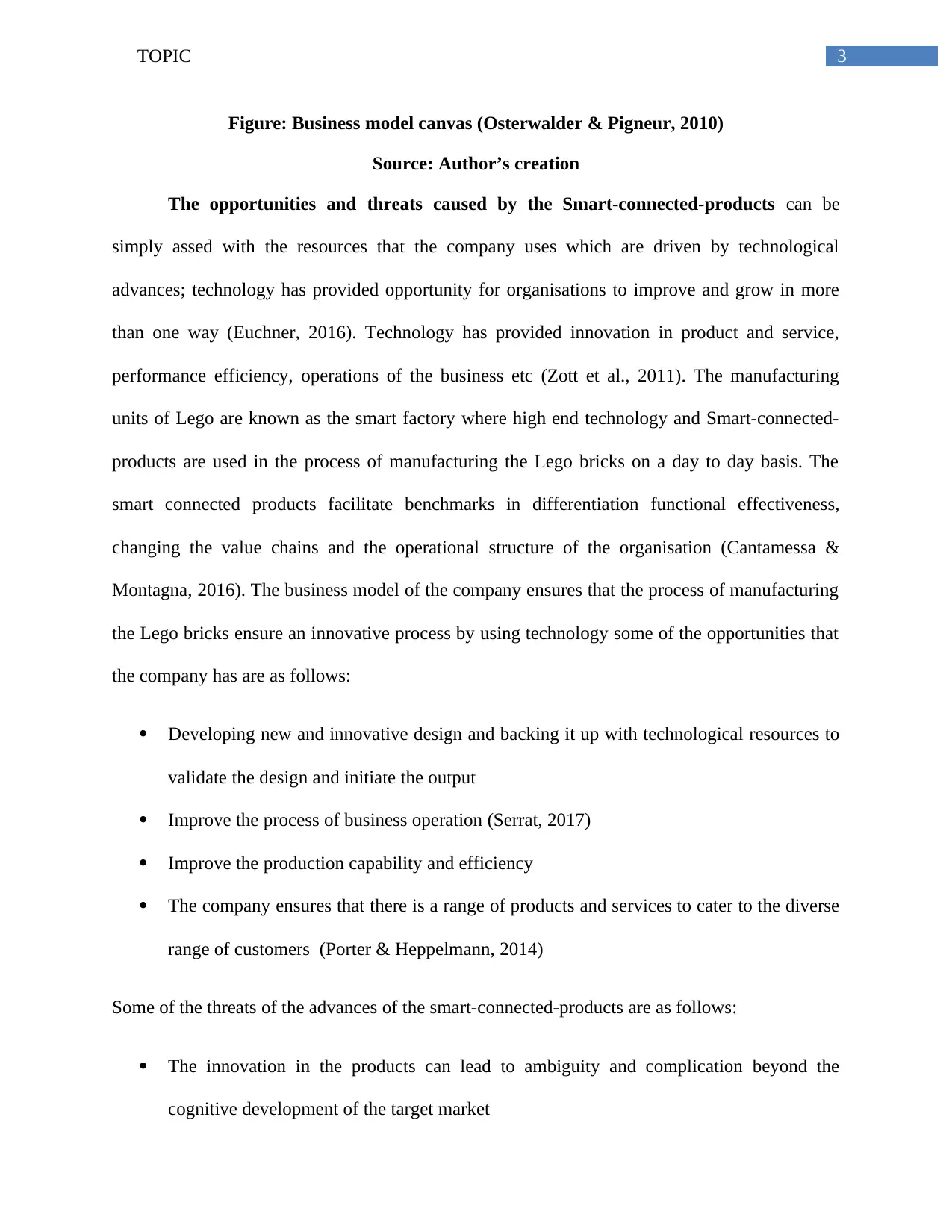
3TOPIC
Figure: Business model canvas (Osterwalder & Pigneur, 2010)
Source: Author’s creation
The opportunities and threats caused by the Smart-connected-products can be
simply assed with the resources that the company uses which are driven by technological
advances; technology has provided opportunity for organisations to improve and grow in more
than one way (Euchner, 2016). Technology has provided innovation in product and service,
performance efficiency, operations of the business etc (Zott et al., 2011). The manufacturing
units of Lego are known as the smart factory where high end technology and Smart-connected-
products are used in the process of manufacturing the Lego bricks on a day to day basis. The
smart connected products facilitate benchmarks in differentiation functional effectiveness,
changing the value chains and the operational structure of the organisation (Cantamessa &
Montagna, 2016). The business model of the company ensures that the process of manufacturing
the Lego bricks ensure an innovative process by using technology some of the opportunities that
the company has are as follows:
Developing new and innovative design and backing it up with technological resources to
validate the design and initiate the output
Improve the process of business operation (Serrat, 2017)
Improve the production capability and efficiency
The company ensures that there is a range of products and services to cater to the diverse
range of customers (Porter & Heppelmann, 2014)
Some of the threats of the advances of the smart-connected-products are as follows:
The innovation in the products can lead to ambiguity and complication beyond the
cognitive development of the target market
Figure: Business model canvas (Osterwalder & Pigneur, 2010)
Source: Author’s creation
The opportunities and threats caused by the Smart-connected-products can be
simply assed with the resources that the company uses which are driven by technological
advances; technology has provided opportunity for organisations to improve and grow in more
than one way (Euchner, 2016). Technology has provided innovation in product and service,
performance efficiency, operations of the business etc (Zott et al., 2011). The manufacturing
units of Lego are known as the smart factory where high end technology and Smart-connected-
products are used in the process of manufacturing the Lego bricks on a day to day basis. The
smart connected products facilitate benchmarks in differentiation functional effectiveness,
changing the value chains and the operational structure of the organisation (Cantamessa &
Montagna, 2016). The business model of the company ensures that the process of manufacturing
the Lego bricks ensure an innovative process by using technology some of the opportunities that
the company has are as follows:
Developing new and innovative design and backing it up with technological resources to
validate the design and initiate the output
Improve the process of business operation (Serrat, 2017)
Improve the production capability and efficiency
The company ensures that there is a range of products and services to cater to the diverse
range of customers (Porter & Heppelmann, 2014)
Some of the threats of the advances of the smart-connected-products are as follows:
The innovation in the products can lead to ambiguity and complication beyond the
cognitive development of the target market
Paraphrase This Document
Need a fresh take? Get an instant paraphrase of this document with our AI Paraphraser
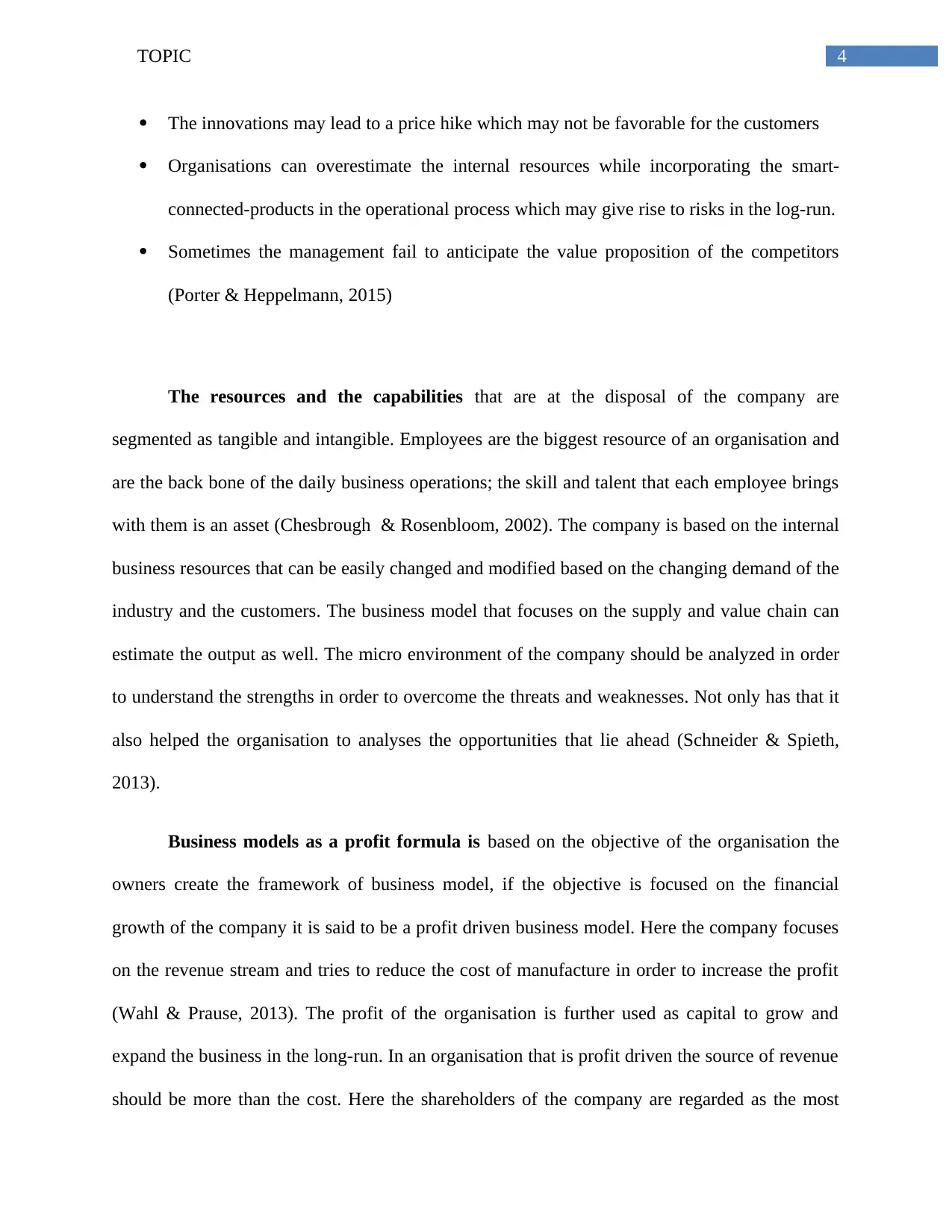
4TOPIC
The innovations may lead to a price hike which may not be favorable for the customers
Organisations can overestimate the internal resources while incorporating the smart-
connected-products in the operational process which may give rise to risks in the log-run.
Sometimes the management fail to anticipate the value proposition of the competitors
(Porter & Heppelmann, 2015)
The resources and the capabilities that are at the disposal of the company are
segmented as tangible and intangible. Employees are the biggest resource of an organisation and
are the back bone of the daily business operations; the skill and talent that each employee brings
with them is an asset (Chesbrough & Rosenbloom, 2002). The company is based on the internal
business resources that can be easily changed and modified based on the changing demand of the
industry and the customers. The business model that focuses on the supply and value chain can
estimate the output as well. The micro environment of the company should be analyzed in order
to understand the strengths in order to overcome the threats and weaknesses. Not only has that it
also helped the organisation to analyses the opportunities that lie ahead (Schneider & Spieth,
2013).
Business models as a profit formula is based on the objective of the organisation the
owners create the framework of business model, if the objective is focused on the financial
growth of the company it is said to be a profit driven business model. Here the company focuses
on the revenue stream and tries to reduce the cost of manufacture in order to increase the profit
(Wahl & Prause, 2013). The profit of the organisation is further used as capital to grow and
expand the business in the long-run. In an organisation that is profit driven the source of revenue
should be more than the cost. Here the shareholders of the company are regarded as the most
The innovations may lead to a price hike which may not be favorable for the customers
Organisations can overestimate the internal resources while incorporating the smart-
connected-products in the operational process which may give rise to risks in the log-run.
Sometimes the management fail to anticipate the value proposition of the competitors
(Porter & Heppelmann, 2015)
The resources and the capabilities that are at the disposal of the company are
segmented as tangible and intangible. Employees are the biggest resource of an organisation and
are the back bone of the daily business operations; the skill and talent that each employee brings
with them is an asset (Chesbrough & Rosenbloom, 2002). The company is based on the internal
business resources that can be easily changed and modified based on the changing demand of the
industry and the customers. The business model that focuses on the supply and value chain can
estimate the output as well. The micro environment of the company should be analyzed in order
to understand the strengths in order to overcome the threats and weaknesses. Not only has that it
also helped the organisation to analyses the opportunities that lie ahead (Schneider & Spieth,
2013).
Business models as a profit formula is based on the objective of the organisation the
owners create the framework of business model, if the objective is focused on the financial
growth of the company it is said to be a profit driven business model. Here the company focuses
on the revenue stream and tries to reduce the cost of manufacture in order to increase the profit
(Wahl & Prause, 2013). The profit of the organisation is further used as capital to grow and
expand the business in the long-run. In an organisation that is profit driven the source of revenue
should be more than the cost. Here the shareholders of the company are regarded as the most
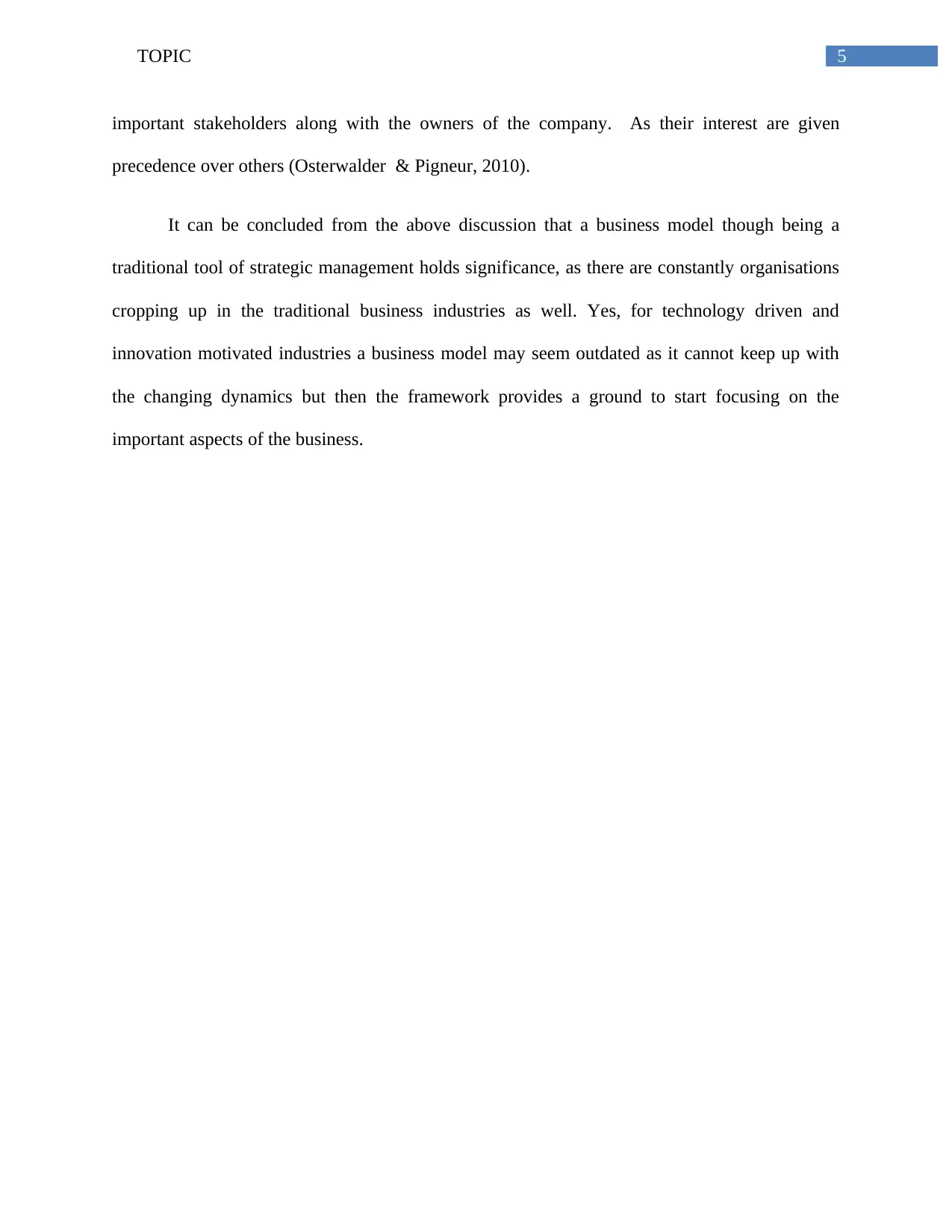
5TOPIC
important stakeholders along with the owners of the company. As their interest are given
precedence over others (Osterwalder & Pigneur, 2010).
It can be concluded from the above discussion that a business model though being a
traditional tool of strategic management holds significance, as there are constantly organisations
cropping up in the traditional business industries as well. Yes, for technology driven and
innovation motivated industries a business model may seem outdated as it cannot keep up with
the changing dynamics but then the framework provides a ground to start focusing on the
important aspects of the business.
important stakeholders along with the owners of the company. As their interest are given
precedence over others (Osterwalder & Pigneur, 2010).
It can be concluded from the above discussion that a business model though being a
traditional tool of strategic management holds significance, as there are constantly organisations
cropping up in the traditional business industries as well. Yes, for technology driven and
innovation motivated industries a business model may seem outdated as it cannot keep up with
the changing dynamics but then the framework provides a ground to start focusing on the
important aspects of the business.
⊘ This is a preview!⊘
Do you want full access?
Subscribe today to unlock all pages.

Trusted by 1+ million students worldwide
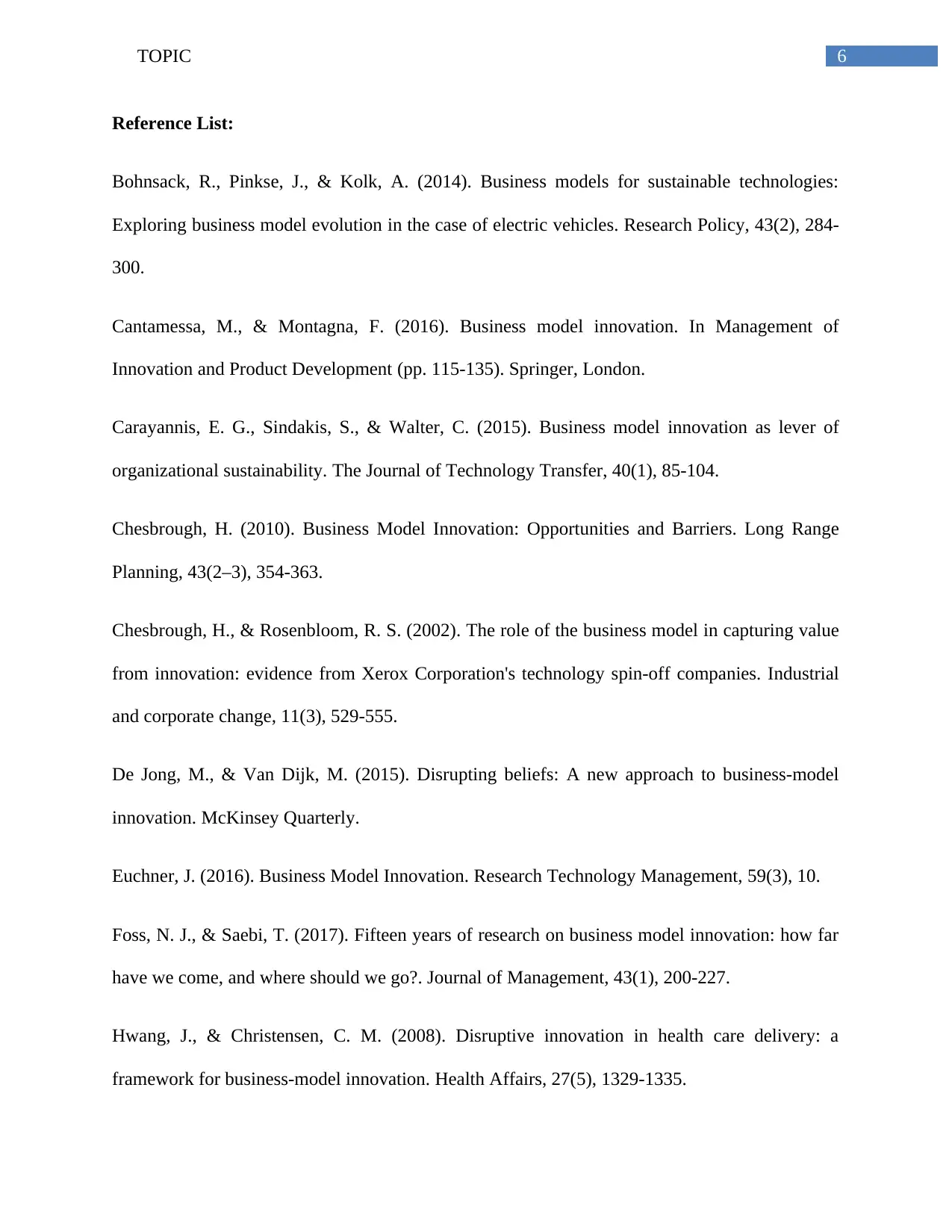
6TOPIC
Reference List:
Bohnsack, R., Pinkse, J., & Kolk, A. (2014). Business models for sustainable technologies:
Exploring business model evolution in the case of electric vehicles. Research Policy, 43(2), 284-
300.
Cantamessa, M., & Montagna, F. (2016). Business model innovation. In Management of
Innovation and Product Development (pp. 115-135). Springer, London.
Carayannis, E. G., Sindakis, S., & Walter, C. (2015). Business model innovation as lever of
organizational sustainability. The Journal of Technology Transfer, 40(1), 85-104.
Chesbrough, H. (2010). Business Model Innovation: Opportunities and Barriers. Long Range
Planning, 43(2–3), 354-363.
Chesbrough, H., & Rosenbloom, R. S. (2002). The role of the business model in capturing value
from innovation: evidence from Xerox Corporation's technology spin‐off companies. Industrial
and corporate change, 11(3), 529-555.
De Jong, M., & Van Dijk, M. (2015). Disrupting beliefs: A new approach to business-model
innovation. McKinsey Quarterly.
Euchner, J. (2016). Business Model Innovation. Research Technology Management, 59(3), 10.
Foss, N. J., & Saebi, T. (2017). Fifteen years of research on business model innovation: how far
have we come, and where should we go?. Journal of Management, 43(1), 200-227.
Hwang, J., & Christensen, C. M. (2008). Disruptive innovation in health care delivery: a
framework for business-model innovation. Health Affairs, 27(5), 1329-1335.
Reference List:
Bohnsack, R., Pinkse, J., & Kolk, A. (2014). Business models for sustainable technologies:
Exploring business model evolution in the case of electric vehicles. Research Policy, 43(2), 284-
300.
Cantamessa, M., & Montagna, F. (2016). Business model innovation. In Management of
Innovation and Product Development (pp. 115-135). Springer, London.
Carayannis, E. G., Sindakis, S., & Walter, C. (2015). Business model innovation as lever of
organizational sustainability. The Journal of Technology Transfer, 40(1), 85-104.
Chesbrough, H. (2010). Business Model Innovation: Opportunities and Barriers. Long Range
Planning, 43(2–3), 354-363.
Chesbrough, H., & Rosenbloom, R. S. (2002). The role of the business model in capturing value
from innovation: evidence from Xerox Corporation's technology spin‐off companies. Industrial
and corporate change, 11(3), 529-555.
De Jong, M., & Van Dijk, M. (2015). Disrupting beliefs: A new approach to business-model
innovation. McKinsey Quarterly.
Euchner, J. (2016). Business Model Innovation. Research Technology Management, 59(3), 10.
Foss, N. J., & Saebi, T. (2017). Fifteen years of research on business model innovation: how far
have we come, and where should we go?. Journal of Management, 43(1), 200-227.
Hwang, J., & Christensen, C. M. (2008). Disruptive innovation in health care delivery: a
framework for business-model innovation. Health Affairs, 27(5), 1329-1335.
Paraphrase This Document
Need a fresh take? Get an instant paraphrase of this document with our AI Paraphraser
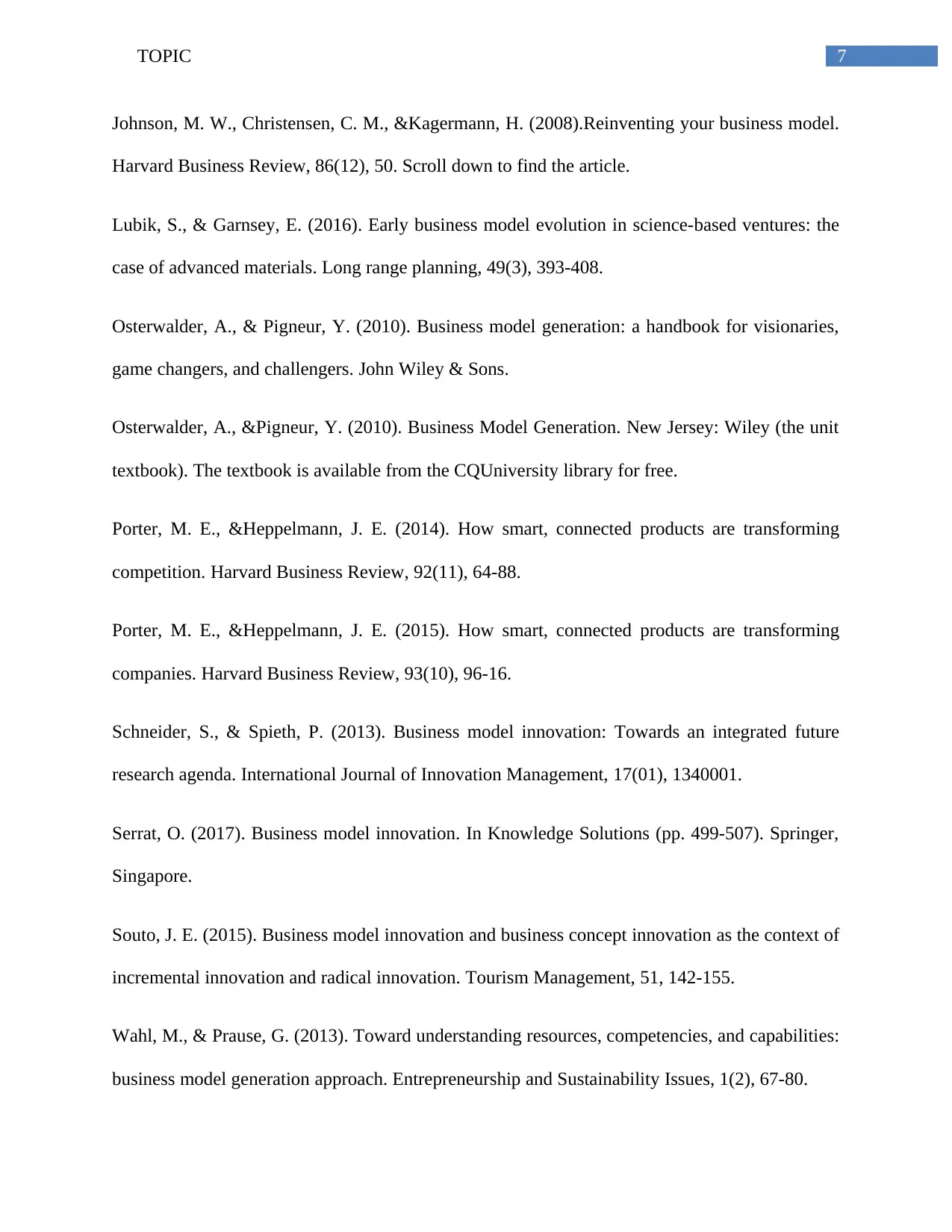
7TOPIC
Johnson, M. W., Christensen, C. M., &Kagermann, H. (2008).Reinventing your business model.
Harvard Business Review, 86(12), 50. Scroll down to find the article.
Lubik, S., & Garnsey, E. (2016). Early business model evolution in science-based ventures: the
case of advanced materials. Long range planning, 49(3), 393-408.
Osterwalder, A., & Pigneur, Y. (2010). Business model generation: a handbook for visionaries,
game changers, and challengers. John Wiley & Sons.
Osterwalder, A., &Pigneur, Y. (2010). Business Model Generation. New Jersey: Wiley (the unit
textbook). The textbook is available from the CQUniversity library for free.
Porter, M. E., &Heppelmann, J. E. (2014). How smart, connected products are transforming
competition. Harvard Business Review, 92(11), 64-88.
Porter, M. E., &Heppelmann, J. E. (2015). How smart, connected products are transforming
companies. Harvard Business Review, 93(10), 96-16.
Schneider, S., & Spieth, P. (2013). Business model innovation: Towards an integrated future
research agenda. International Journal of Innovation Management, 17(01), 1340001.
Serrat, O. (2017). Business model innovation. In Knowledge Solutions (pp. 499-507). Springer,
Singapore.
Souto, J. E. (2015). Business model innovation and business concept innovation as the context of
incremental innovation and radical innovation. Tourism Management, 51, 142-155.
Wahl, M., & Prause, G. (2013). Toward understanding resources, competencies, and capabilities:
business model generation approach. Entrepreneurship and Sustainability Issues, 1(2), 67-80.
Johnson, M. W., Christensen, C. M., &Kagermann, H. (2008).Reinventing your business model.
Harvard Business Review, 86(12), 50. Scroll down to find the article.
Lubik, S., & Garnsey, E. (2016). Early business model evolution in science-based ventures: the
case of advanced materials. Long range planning, 49(3), 393-408.
Osterwalder, A., & Pigneur, Y. (2010). Business model generation: a handbook for visionaries,
game changers, and challengers. John Wiley & Sons.
Osterwalder, A., &Pigneur, Y. (2010). Business Model Generation. New Jersey: Wiley (the unit
textbook). The textbook is available from the CQUniversity library for free.
Porter, M. E., &Heppelmann, J. E. (2014). How smart, connected products are transforming
competition. Harvard Business Review, 92(11), 64-88.
Porter, M. E., &Heppelmann, J. E. (2015). How smart, connected products are transforming
companies. Harvard Business Review, 93(10), 96-16.
Schneider, S., & Spieth, P. (2013). Business model innovation: Towards an integrated future
research agenda. International Journal of Innovation Management, 17(01), 1340001.
Serrat, O. (2017). Business model innovation. In Knowledge Solutions (pp. 499-507). Springer,
Singapore.
Souto, J. E. (2015). Business model innovation and business concept innovation as the context of
incremental innovation and radical innovation. Tourism Management, 51, 142-155.
Wahl, M., & Prause, G. (2013). Toward understanding resources, competencies, and capabilities:
business model generation approach. Entrepreneurship and Sustainability Issues, 1(2), 67-80.
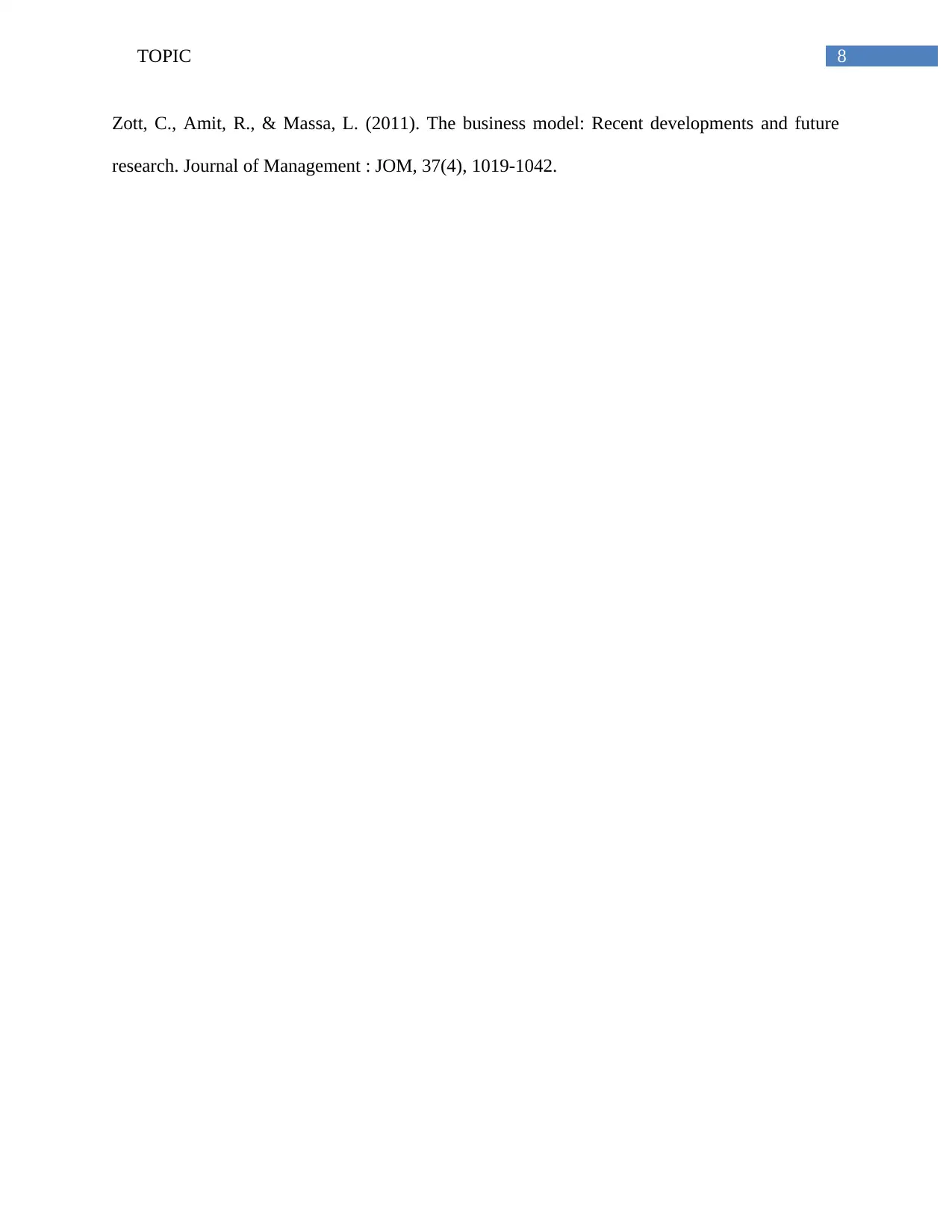
8TOPIC
Zott, C., Amit, R., & Massa, L. (2011). The business model: Recent developments and future
research. Journal of Management : JOM, 37(4), 1019-1042.
Zott, C., Amit, R., & Massa, L. (2011). The business model: Recent developments and future
research. Journal of Management : JOM, 37(4), 1019-1042.
⊘ This is a preview!⊘
Do you want full access?
Subscribe today to unlock all pages.

Trusted by 1+ million students worldwide
1 out of 9
Related Documents
Your All-in-One AI-Powered Toolkit for Academic Success.
+13062052269
info@desklib.com
Available 24*7 on WhatsApp / Email
![[object Object]](/_next/static/media/star-bottom.7253800d.svg)
Unlock your academic potential
Copyright © 2020–2025 A2Z Services. All Rights Reserved. Developed and managed by ZUCOL.


